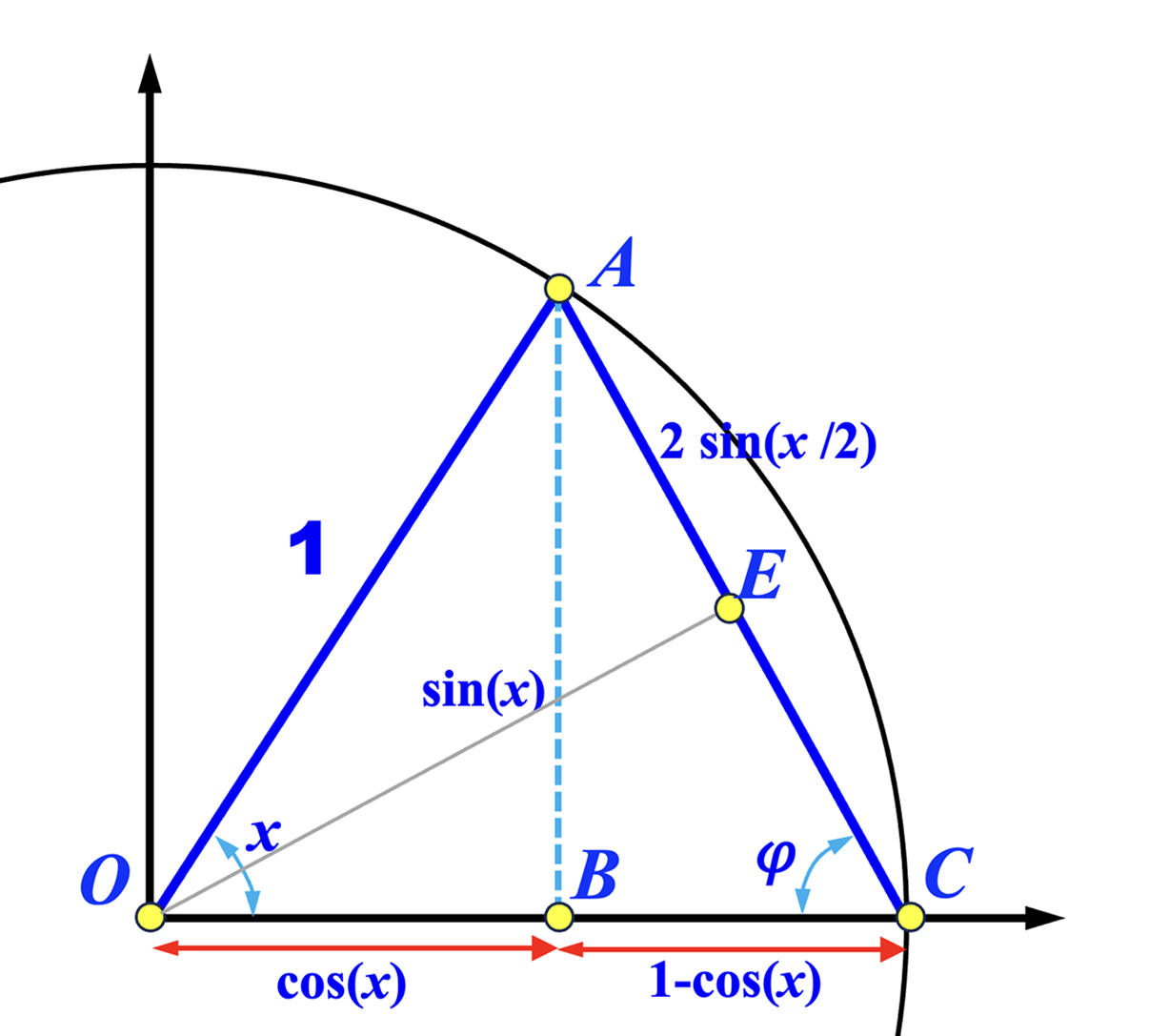Half-Angle Identities for \( \sin() \) and \( \cos() \)
Ching-Kuang Shene (冼鏡光), Professor Emeritus
Department of Computer Science
Michigan Technological University
Houghton, MI 49931
USA
Created October 6, 2025
![]()
Ching-Kuang Shene (冼鏡光), Professor Emeritus
Department of Computer Science
Michigan Technological University
Houghton, MI 49931
USA
Created October 6, 2025
![]()
We all know the half-angle identities for \( \sin() \) and \( \cos() \) as follows: $$ \begin{eqnarray*} \sin\left( \frac{x}{2}\right) &=& \pm\sqrt{\frac{1-\cos(x)}{2}} \\ \cos\left( \frac{x}{2}\right) &=& \pm\sqrt{\frac{1+\cos(x)}{2}} \end{eqnarray*} $$ We shall prove these identities without using the Pythagorean Identity. Most materials on this page will be repeated in Luzia's 2015 Proof.
Consider a unit circle with center \( O \). Let \( \overleftrightarrow{OC} \) and \( \overleftrightarrow{OA} \) make an angle of \( x \), where \( A \) and \( C \) are on the circle and \( \overleftrightarrow{OC} \) is the x-axis. Without loss of generality, we assume \( 0 \leq x \leq 90^{\circ} \). Let \( E \) be the mid-point of \( \overline{AC} \). Let \( \varphi = \angle ACO \). From right triangle \( \bigtriangleup OCE \) we have \( \varphi = 90^{\circ} - \frac{x}{2} \) and hence \( \sin(\varphi) = \cos\left(\frac{x}{2}\right)\), \( \cos(\varphi) = \sin\left(\frac{x}{2}\right) \) and \( \overline{EC} = \sin\left( \frac{x}{2}\right) \). Therefore, \( \overline{AC}=2\overline{EC}=2\sin\left(\frac{x}{2}\right) \). From right triangle \( \bigtriangleup AOB \) we have \( \overline{OB} = \cos(x) \) and \( \overline{BC} = 1 - \cos(x) \). From right triangle \( \bigtriangleup ACB \) we have \[ \overline{BC}=\overline{AC}\cos(\varphi) =\overline{AC}\sin\left(\frac{x}{2}\right) = 2\sin^2\left(\frac{x}{2} \right) \] Because we have \[ 1-\cos(x) = \overline{BC} = 2\sin^2\left( \frac{x}{2}\right) \] rearranging yields the half-angle identity for \( \sin() \): \[ \sin^2\left( \frac{x}{2} \right) = \frac{1-\cos(x)}{2} \mbox{\ \ \ \ \ \ \ \ \ \ or \ \ \ \ \ \ \ \ \ \ } \sin\left(\frac{x}{2}\right) = \pm\sqrt{\frac{1-\cos(x)}{2}} \]

|
We have seen the double angle identities double angle identities for \( \cos(x) \): \[ \cos(x) = \cos^2\left( \frac{x}{2} \right) - \sin^2\left( \frac{x}{2} \right) \] Plugging in the \( \sin^2(x/2) \) obtained earlier, rearranging and simplifying yields: \[ \cos^2\left( \frac{x}{2} \right) = \frac{1+\cos(x)}{2} \mbox{\ \ \ \ \ \ \ \ \ \ or \ \ \ \ \ \ \ \ \ \ } \cos\left(\frac{x}{2}\right) = \pm\sqrt{\frac{1+\cos(x)}{2}} \]
Neither the Pythagorean Theorem nor the Pythagorean Identity was used in deriving the half-angle identities. Therefore, the half-angle identities are independent of the Pythagorean Theorem and the Pythagorean Identity.
A quick note is necessary: from the identities for \( \sin^2(x/2) \) and \( \cos^2(x/2) \) the Pythagorean Identity is obvious. Moreover, due the symmetry and periodicity of \( \sin() \) and \( \cos() \), it is EASY to obtain the same results for any \( x \).
Go back to Home Page.